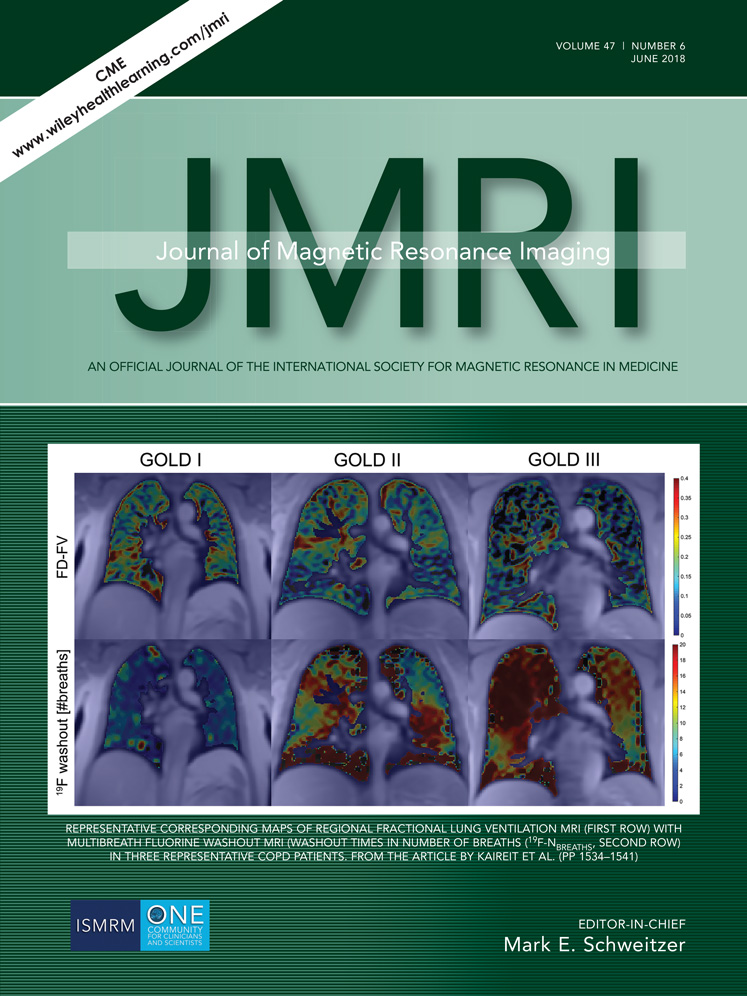Multiparametric characterization of response to anti-angiogenic therapy using USPIO contrast-enhanced MRI in combination with dynamic contrast-enhanced MRI
Abstract
Background
Steady state susceptibility contrast (SSC)-MRI provides information on vascular morphology but is a rarely used method.
Purpose
To investigate the utility of the ultrasmall superparamagnetic iron oxide particles (USPIOs) GEH121333 for measuring tumor response to bevacizumab and compare this with gadolinium-based DCE-MRI.
Study Type
Prospective preclinical animal model study.
ANIMAL MODEL
Mice bearing subcutaneous TOV-21G human ovarian cancer xenografts treated with bevacizumab (n = 9) or saline (n = 9).
Field Strength/Sequence
Imaging was performed on a 7T Bruker Biospec. For SSC-MRI with GEH121333 we acquired R1-maps (RARE-sequence with variable TR), R2-maps (multi-spin echo), and
 -maps (multi-gradient echo). Additionally, R1 and R2 maps were measured on the days after USPIO injection. For DCE-MRI with gadodiamide we acquired 200 T1-weighted images (RARE-sequence).
-maps (multi-gradient echo). Additionally, R1 and R2 maps were measured on the days after USPIO injection. For DCE-MRI with gadodiamide we acquired 200 T1-weighted images (RARE-sequence).
Assessment
ΔR1, ΔR2, and
 maps were computed from SSC-MRI. DCE-MRI was analysed using the extended Tofts model.
maps were computed from SSC-MRI. DCE-MRI was analysed using the extended Tofts model.
Statistical Tests
Results from pre- and 3 days posttreatment SSC-MRI were compared using paired-sample t-tests. Treatment and control groups were compared using independent sample t-tests. Performance of SSC- and DCE-MRI was compared using multivariate partial least squares discriminant analysis.
Results
Already one day after treatment and USPIO injection, R1 and R2 values were lower in treated (R1 = 0.49 ± 0.03s−1, R2 = 23.07 ± 1.49s−1) compared with control tumors (R1 = 0.52 ± 0.02s−1, R2 = 24.98 ± 1.01s−1), indicating lower USPIO accumulation. Posttreatment SSC-MRI displayed significantly decreased tumor blood volume (change in ΔR2 = -0.43 ± 0.26s−1, P = 0.001) and vessel density (change in Q = -0.032 ± 0.020s−1/3, P = 0.002). DCE-MRI showed among others lower Ktrans in treated tumors (control = 0.064 ± 0.011min−1, tx = 0.046 ± 0.008min−1, P = 0.002). Multivariate analysis suggests that SSC-MRI was slightly inferior to DCE-MRI in distinguishing treated from control tumors (accuracy = 75%, P = 0.058 versus 80%, P = 0.028), but a combination of both was best (accuracy = 85%; P = 0.003).
Data Conclusion
SSC-MRI with GEH121333 is sensitive to early (<24 h) and late changes in tumor vasculature. SSC-MRI and DCE-MRI provide complementary information and can be used to assess different aspects of vascular responses to anti-angiogenic therapies.
Level of Evidence: 1
Technical Efficacy: Stage 2
J. Magn. Reson. Imaging 2018;47:1589–1600.




